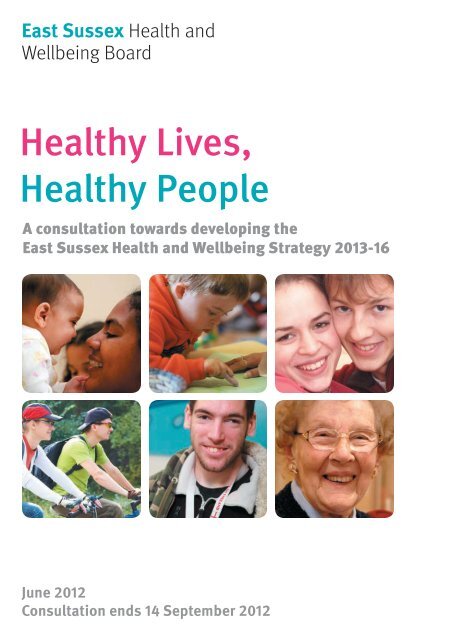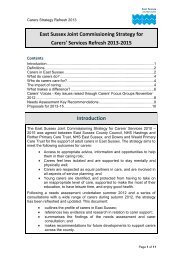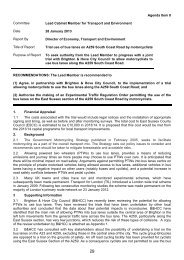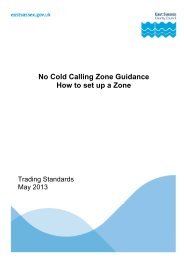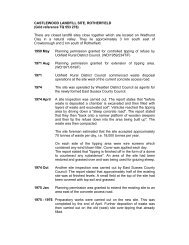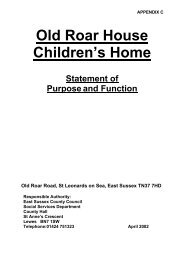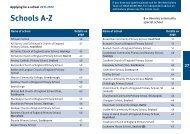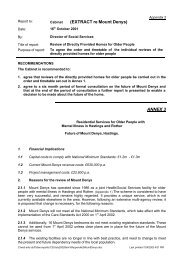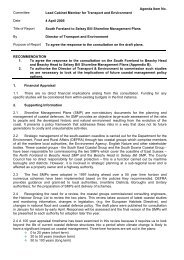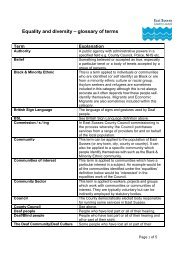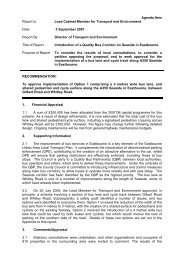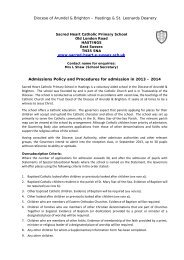Healthy Lives, Healthy People - East Sussex County Council
Healthy Lives, Healthy People - East Sussex County Council
Healthy Lives, Healthy People - East Sussex County Council
- No tags were found...
You also want an ePaper? Increase the reach of your titles
YUMPU automatically turns print PDFs into web optimized ePapers that Google loves.
ContentsForeword ......................................................................... 3Summary ......................................................................... 4Introduction ...................................................................... 5Where we are now ................................................................ 6About <strong>East</strong> <strong>Sussex</strong> .................................................................. 6Health and wellbeing in <strong>East</strong> <strong>Sussex</strong> .................................................. 6What is already being done to improve health and wellbeing and reduce inequalities ....... 6Where we want to be .............................................................. 8Our vision. ......................................................................... 8A whole life approach. .............................................................. 8• Every child has a good start in life ................................................. 8• Children and young people develop well ........................................... 8• Adults live healthy lives and have healthier lifestyles................................. 8• Workplaces promote health and wellbeing.......................................... 8• Older people live healthy and independent lives .................................... 8• High quality and choice of care at the end of life..................................... 8An integrated, whole system approach ................................................ 8Our priorities ..................................................................... 91. The best possible start for all babies and young children ............................. 92. Safe, resilient, secure parenting for all children and young people.................... 103. Reducing the harm caused by alcohol and tobacco..................................114. Preventing and reducing falls, accidents and injuries. ............................... 125. Enabling people to manage and maintain their mental health and wellbeing........... 136. Supporting those with special educational needs, disabilities and long term conditions. 147. High quality and choice of end of life care. ........................................ 15Delivering and measuring success ................................................ 16What happens next............................................................... 16Glossary of terms .................................................................17For more information . ............................................................ 182
ForewordThis consultation document is the first step indeveloping a Health and Wellbeing Strategy for <strong>East</strong><strong>Sussex</strong> that addresses the health and wellbeingneeds of our residents at every stage of their lives.Our residents generally enjoy a high quality oflife and a better life expectancy than the nationalaverage but there are differences and inequalitieswithin and between different parts of the county,and things that we could do better together to makefurther improvements and make the best use of themoney we have available to us.At this early stage, we are asking you to tell us ifyou think the areas we have chosen are the mostappropriate for the <strong>East</strong> <strong>Sussex</strong> Health and WellbeingBoard to focus on over the next three years.There is already a lot of work going on to protect andimprove people’s health and wellbeing and reducehealth inequalities. The Health and Wellbeing Boardwill take an overview of existing work by partnershipsand agencies.The Board is a partnership between LocalGovernment, the NHS and the people of <strong>East</strong> <strong>Sussex</strong>.Members include local GPs, county councillors,the local Healthwatch and senior county councilofficers overseeing Public Health, Adult Social Careand Children’s services. The Board is supportedby an Assembly made up of a wide range oforganisations from the public, private and voluntaryand community sectors that are all interested andinvolved in improving local people’s health andwellbeing.This new partnership gives us the opportunity to lookacross the whole health and care system, make sureit is well connected and to change the way we workwhere it will improve outcomes, change behavioursand make the delivery of services more effective andefficient.We believe that this new approach to whole systemworking focusing on health and wellbeing in thecounty will have a powerful impact. It will affect howlocal people support their own quality of life, howcommissioners and service providers work togetherto improve the health and wellbeing of the wholepopulation, and engage a much wider range ofpartners in our joint mission.The <strong>East</strong> <strong>Sussex</strong> Health and Wellbeing Boardmembers are committed to working with existingcommissioning boards, partnership boards, deliverygroups and the public in <strong>East</strong> <strong>Sussex</strong> to makedecisions about health and wellbeing more inclusiveand to make sure our efforts are joined up.That’s why it is important to hear from you– residents, patients, service users, carers,commissioners and service providers - aboutwhether we have chosen the best areas on which toconcentrate our efforts over the next three years.Over the coming weeks, we will be listening to yourviews while we develop plans further. We will thenpublish a draft strategy in October and the finalstrategy and action plan in December.Cllr Sylvia TidyChairman<strong>East</strong> <strong>Sussex</strong> Health and Wellbeing Board3
<strong>East</strong> <strong>Sussex</strong> Health and Wellbeing Strategy ConsultationSummary4The health and wellbeing of the half a millionresidents in <strong>East</strong> <strong>Sussex</strong> is generally good and mostpeople can expect to live a long life. There are,however, some significant challenges in the countyand some people and communities that experienceworse health and wellbeing than others.The <strong>East</strong> <strong>Sussex</strong> Health and Wellbeing Board bringstogether Local Government, the NHS and the peopleof <strong>East</strong> <strong>Sussex</strong>. Members include local GPs, countycouncillors, senior <strong>County</strong> <strong>Council</strong> officers overseeingPublic Health, Adult Social Care and Children’sServices, and the local Healthwatch – a new localvoice for people who use and need health and socialcare services. Our vision is to protect and improvehealth and wellbeing and reduce health inequalitiesin <strong>East</strong> <strong>Sussex</strong>. This consultation is the first stepin developing a Health and Wellbeing Strategythat will help deliver that vision through joined up,coordinated and integrated health and wellbeingservices.The Board recognises and aims to add value to thevast amount of partnership work already underwayto address people’s health and wellbeing needs. Thestrategy will therefore not be a long list of everythingthat is already being done to protect and improvehealth and wellbeing and reduce health inequalities.Instead, based on local evidence, it will focus onthe issues that require the greatest attention in <strong>East</strong><strong>Sussex</strong> and where the Health and Wellbeing Boardcan make a real difference.The Board will consider how changing the way we allwork together can improve health and wellbeing in<strong>East</strong> <strong>Sussex</strong> and deliver efficiency savings that couldbe re-invested in service improvements. In additionto protecting and improving the health and wellbeingof everyone in <strong>East</strong> <strong>Sussex</strong>, some actions will betargeted at those groups of people and local areasthat are experiencing the worst health in order to‘narrow the gap’ and reduce inequalities.The Board will take a whole life approach byconsidering people’s health and wellbeing fromconception to death, and take into account widerfactors that affect people’s health and wellbeing, forexample, housing, employment, the environmentand community safety. By taking this approach wewant to ensure that, in <strong>East</strong> <strong>Sussex</strong>, every child has agood start in life; children and young people developwell; adults live healthy lives and have healthierlifestyles; workplaces promote health and wellbeing;older people live healthy and independent lives; andpeople have high quality and choice of care at theend of life.The areas we propose to focus on over the next threeyears are:• The best possible start for all babies and youngchildren• Safe, resilient, secure parenting for all childrenand young people• Reducing the harm caused by alcohol andtobacco• Preventing and reducing falls, accidents andinjuries• Enabling people to manage and maintain theirmental health and wellbeing• Supporting those with special educationalneeds, disabilities and long term conditions• High quality and choice of end of life carePlease let us have your views on the proposed areasof focus to help guide the next stage of developingthe strategy. Following this consultation, a draftstrategy will be published in October with a finalstrategy and action plan published in December2012.For those interested in the evidence base andstrategy development process, please see theaccompanying Supporting Information Document.A glossary of terms can be found on page 17 of thisdocument.
<strong>East</strong> <strong>Sussex</strong> Health and Wellbeing Strategy ConsultationIntroductionThe <strong>East</strong> <strong>Sussex</strong> Health and Wellbeing Board’srole is to assess the needs of the local populationthrough the Joint Strategic Needs Assessment;produce a Health and Wellbeing Strategy to providea framework to inform the commissioning of health,social care and public health services in <strong>East</strong><strong>Sussex</strong> and, where relevant, other local servicesthat promote health and wellbeing; and to promotegreater integration across health and social care.This consultation is the first step in developing aHealth and Wellbeing Strategy for <strong>East</strong> <strong>Sussex</strong>. Usingthe <strong>East</strong> <strong>Sussex</strong> Joint Strategic Needs Assessmentand other data sources, the strategy identifies thehealth and wellbeing needs of <strong>East</strong> <strong>Sussex</strong> residentsnow and in the future, and sets out how those needswill be met through the commissioning of services,joint working and collective action.The strategy focuses on local outcomes that aresignificantly worse than the England average, majorlifestyle and demographic issues, and where a morejoined up approach will help to improve outcomes,reduce inequalities and help to manage demand infuture years. The strategy is not therefore a long listof all the health and wellbeing issues in <strong>East</strong> <strong>Sussex</strong>,but focuses on a small number of big issues wherethe Board can make a real difference.The purpose of this consultation is to test outwhether you agree with the areas we propose tofocus on, what we plan to do and what we aim toachieve over the next three years.For those interested in the evidence base andstrategy development process, please see theaccompanying Supporting Information Document.A glossary of terms can be found on page 17 of thisdocument.5
<strong>East</strong> <strong>Sussex</strong> Health and Wellbeing Strategy ConsultationWhere we want to beOur visionOur vision is to protect and improve health andwellbeing and reduce health inequalities in <strong>East</strong><strong>Sussex</strong> so that everyone has the opportunity to havea healthy, safe and fulfilling life.This is part of a broader partnership vision set outin the <strong>East</strong> <strong>Sussex</strong> Sustainable Community Strategy,Pride of Place, to create and sustain:• A vibrant, diverse and sustainable economy;• Great places to live in, visit and enjoy; and• Safe, healthy and fulfilling livesA whole life approachWe will consider health and wellbeing fromconception to death and take into account widerfactors that can affect people’s health and wellbeing,for example the importance of a decent place to live,employment and leisure activities. Although eachlife stage deserves particular attention, a whole lifeapproach enables links to be made along the lifecourse. By taking this approach we want to ensurethat, in <strong>East</strong> <strong>Sussex</strong>:• Every child has a good start in life: a safe,healthy and happy childhood provides thefoundation for every child to thrive and achievetheir potential.• Children and young people develop well:the physical health and mental wellbeing ofchildren and young people coupled with goodeducational achievement are essential to a goodquality of life and good chances in adulthood.• Adults live healthy lives and have healthierlifestyles: alongside other factors such as poorhousing and unemployment, unhealthy lifestylescan lead to a range of physical and mentalhealth problems later in life and, in some cases,a lower life expectancy.• Workplaces promote health and wellbeing:unemployment can affect people’s health,healthy employees are more productive andworkplaces can be used to promote healthierlifestyle choices.• Older people live healthy and independentlives: as people live longer it is essential thatolder people have a good level of health andwellbeing to enable them to live fulfilling andindependent lives.• High quality and choice of care at the end oflife: everyone diagnosed with a terminal illnessdeserves equal access to the highest quality endof life care and to die in their preferred place ofdeath.An integrated, whole systemapproachWe want to build on the work already taking placeto close the traditional divide between health,social care and other services that affect people’shealth and wellbeing so that individuals get ‘joinedup’ services that address their needs. This involvesbringing together and joining up every aspect ofdesigning, commissioning and delivering preventionand early intervention, diagnosis, treatment, care,re-ablement, rehabilitation and health improvementand promotion services to ensure people get theright support, in the right place, at the right time.A ‘whole system’ is not just about getting differentorganisations working together – this alreadyhappens in <strong>East</strong> <strong>Sussex</strong> – it is also about gatheringand sharing local information and knowledge tounderstand the impact that changes in one part ofthe system have on everything else, for example theimpact of increasing, or reducing, early interventionand prevention on the number of hospitaladmissions and how one health and wellbeingissue might impact on another, for example, alcoholmisuse and chronic health conditions.8
<strong>East</strong> <strong>Sussex</strong> Health and Wellbeing Strategy ConsultationOur prioritiesWe believe the Health and Wellbeing Board should focuson the following areas over the next three years:• The best possible start for allbabies and young children• Safe, resilient, secure parentingfor all children and youngpeople• Reducing the harm caused byalcohol and tobacco• Preventing and reducing falls,accidents and injuries• Enabling people to manage andmaintain their mental healthand wellbeing• Supporting those with specialeducational needs, disabilitiesand long term conditions• Providing high quality andchoice of end of life care1 The best possible start for all babies and young childrenWe know much more now than we did 10 years ago about the impact on children’s long term emotional andintellectual development of not getting a good start in life. The first years, particularly the first 12 months,are a period in which good, loving care is essential both for good mental health and development of keycommunication and social skills. This is why successive national reports and Government policy statementshave emphasised the need to identify vulnerable parents and give them the support they need to nurturetheir children. Failure to get the care they need in infancy leads to poor outcomes for children not just ineducation but in their wider health and wellbeing. In <strong>East</strong> <strong>Sussex</strong> we know there are significant gaps inoutcomes when children are assessed at primary schools at age 5, with only 49% of children in Hastings, forexample, reaching the expected benchmark level for language and communication skills.What we plan to do:We want to ensure that monitoring of infant healthand development reaches all families so thatthose with problems are identified early, and toincrease the amount of targeted support providedto parents of young children who are struggling.Making sure we support all those who mostneed it, in a way which is really effective, requiresthe effort and cooperation of a wide range oforganisations and individuals and is crucial to thelong term well being of our communities.What we aim to achieve:Over the next three years we would expect tosee an improvement in the development ofyoung children in areas with the lowest levelscurrently, as measured through the assessmentsat age 5. We would also be looking for furtherimprovement in the numbers of mothers choosingand able to breastfeed their children given thewell researched benefits this brings, and a steadyincrease in the number of families provided withtargeted additional support from health and otherprofessionals, including through local children’scentres.9
<strong>East</strong> <strong>Sussex</strong> Health and Wellbeing Strategy Consultation2 Safe, resilient, secure parenting for all children and young peopleGood parenting is essential to the health and wellbeing of children of all ages. In the case of some childrenand young people we know that their parents struggle to keep them safe and to support their mental andphysical development. <strong>East</strong> <strong>Sussex</strong> has seen a growing number of children and young people requiringsupport from statutory social care services in recent years, including rising numbers of children who need tobe cared for through fostering and adoption. Between 2006 and 2011 the rate of children with a statutoryChild Protection Plan rose from 36 to 60 children per 10,000. The number of Looked After Children increasedfrom 445 to 589 in the same time period. The reasons behind poor parenting are complex and vary fromfamily to family. They can include poor mental health of parents, their substance or alcohol use or addiction,the presence of domestic abuse in a household. They can also include for some parents a struggle to managetheir child’s behaviour, health conditions, or disabilities, a lack of suitable role models or practical help inlife, and difficulty understanding how to meet a child’s needs consistently. Often families where these thingsare present also have a range of services trying to address the needs of various family members, making theissues even more complex.What we plan to do:We want to place child safety and wellbeing at thecentre of developing our support for parents, andto recognise fully the impact of adult’s needs ontheir children, providing a good menu of earlierhelp when parents first have difficulties, andassertive and powerful support when things reallyneed to improve for their children to be safe. Wealso want to provide more joined up support forfamilies through whole family key working servicesand to build resilience in families so they cansupport each other when facing difficulties.What we aim to achieve:Over the next three years we would expect to seean increased number of families receiving earlyhelp to tackle problems, an increase in the numberof coordinated whole family support plans beingled by a family key worker, and a reduction in thenumber of children and young people who needstatutory Child Protection Plans or that need to beremoved from their parents.10
<strong>East</strong> <strong>Sussex</strong> Health and Wellbeing Strategy Consultation3 Reducing the harm caused by alcohol and tobaccoAlcoholExcessive alcohol consumption can lead to a range of health conditions including liver and heart disease.We estimate that 19% of the <strong>East</strong> <strong>Sussex</strong> population are drinking at levels likely to cause harm or alreadycausing harm. In some parts of the county the estimated percentage of people drinking at higher risk levelsis amongst the highest in the country. The long term effects of excessive alcohol consumption are a majorcause of hospital admissions. In 2009/10 alone 6,691 people (all ages) were admitted to hospital with analcohol attributable condition and 1,538 with an alcohol specific condition. Drinking among young people insome parts of the county is above the national average. Drinking amongst young people can be associatedwith other issues such as offending, truancy, drug misuse and alcohol related health conditions in later life.Alongside the health impacts and the economic burden of loss of employment and reduced capacity to work,alcohol is also a contributory factor in a number community safety issues.What we plan to do:We want to support the development of a moresystematic and integrated approach to alcoholmisuse.What we aim to achieve:Over the next three years we would expect to see areduction in risky drinking behaviour, fewer alcoholrelated hospital admissions, and a reduction inalcohol related crime.SmokingSmoking can lead to a range of health conditions such as heart disease, stroke and cancer. There are over1,000 smoking related deaths in <strong>East</strong> <strong>Sussex</strong> each year – more than the combined total of the six nextgreatest causes of preventable deaths. Smoking is also linked to other issues such as crime and fires. 90%of smokers begin smoking before the age of 19 and in <strong>East</strong> <strong>Sussex</strong> it is estimated that 15% of children aged14-15 smoke. Smoking in pregnancy can cause miscarriages and perinatal deaths, yet on average 17% ofpregnant women in <strong>East</strong> <strong>Sussex</strong> smoke, rising to almost 25% in some parts of the county. Smoking is also thebiggest cause of health inequalities in the UK accounting for half the difference in life expectancy betweenrichest and poorest. Nationally the proportion of the population who smoke has fallen and this is the caseoverall for <strong>East</strong> <strong>Sussex</strong> with self reported smoking rates falling to around 17% in 2011, although rates ofsmoking in Hastings and <strong>East</strong>bourne appear to have fallen very little or not at all.What we plan to do:We want to support the development of asystematic and co-ordinated approach to smokingand tobacco control.What we aim to achieve:Over the next three years we would expect to seea reduction in the percentage of smokers in thegeneral population and in women smoking duringpregnancy, fewer young people taking up smokingand a reduction in illegal and illicit tobaccoproducts.11
<strong>East</strong> <strong>Sussex</strong> Health and Wellbeing Strategy ConsultationUnintentional and deliberate injuries amongst children and young peopleAccidents and learning about how to stay safe are part of growing up, but children should not be injured inaccidents that can be prevented or be deliberately harmed. Between 2009/10 and 2010/11 there were 2,885admissions to hospital in <strong>East</strong> <strong>Sussex</strong> for under 18 year olds who were injured in accidents or deliberately.41% of these were caused by falls, particularly amongst younger children. 11% were deliberate harm – eitherassaults or self-harm. Another significant cause of accidental injury was road traffic accidents, with 20% ofaccidental injuries for 11-16 year olds resulting in this way. Hospital admissions as a result of accidents havea high correlation with deprivation factors in local communities, with significantly higher admission rates for asmall number of wards or areas across the county.What we plan to do:We want to make sure that we are following theevidence base produced by the National Institutefor Health and Clinical Excellence and others indelivering help – such as home safety equipmentschemes and checks – in the most effectiveway. We also want to join up the personal safetymessages that are given in schools and colleges,including by the Police, Fire and Rescue Service,county council and teachers themselves.What we aim to achieve:Over the next three years we would expect to seea reduction in the admission rate of children andyoung people to hospital for unintentional anddeliberate injuries.5 Enabling people to manage and maintain their mental health andwellbeingThere are higher than national average levels of depression, psychosis and hospital admissions for self-harmin <strong>East</strong> <strong>Sussex</strong>. Many things can increase a person’s chance of becoming depressed or developing othermental health conditions – bereavement, substance misuse, isolation, a long term health condition, schoolbullying, workplace stress or debt for example. Spotting problems early and supporting people before thingsget worse is therefore everyone’s business. Community based and secondary care based mental healthservices are already working well together and delivering positive outcomes for those diagnosed with amental health condition. However, more needs to be done to break down the stigma associated with mentalhealth, to identify people at risk earlier and support them and their carers to manage and maintain theirmental health in ways that best suits them.What we plan to do:What we aim to achieve:We want to support the development of a ‘wholesystem’ approach to early identification, advice,recovery and care planning across the county anda more personalised approach to help peoplemanage their condition better. We also want toensure that the pathway of support for children andyoung people with emerging mental health needsis clear so that the best use is made of the differentservices on offer.Over the next three years we would expect to seemore young people and adults being diagnosedand treated for a mental health condition, moreuse of community based support for children andyoung people, more people with a comprehensivecare plan, fewer hospital admissions for self-harmand fewer suicides.13
<strong>East</strong> <strong>Sussex</strong> Health and Wellbeing Strategy Consultation6 Supporting those with special educational needs, disabilities andlong term conditionsSpecial educational needs and disabilitiesIt is estimated that 6% of the population has some form of disability although not all will need intensivehelp and support. The incidence of disability has risen fastest amongst children and trends indicateincreasing numbers of children being reported as having complex needs, Autistic Spectrum Disorders andmental health issues. Of the estimated 4,500 children with disabilities aged 0-19 in <strong>East</strong> <strong>Sussex</strong>, about halfwill have a moderate to severe disability. There are over 2,200 2-19 year olds with a statement of specialeducational needs (SEN) in <strong>East</strong> <strong>Sussex</strong> and around 11,000 young people who do not have a statementbut who may require support during transition to adulthood. Over the next seven years it is estimated that600-800 young people in the county will need ongoing support after leaving full time education as a resultof a disability. We estimate that there are more than 2,000 adults with learning disabilities in the county, anumber that is predicted to grow by 10% by 2020 in part due to improved health care resulting in an increasein life expectancy. The number of infants with profound and multiple learning disabilities surviving intoadulthood and the number of older people with learning disabilities are also expected to increase as their lifeexpectancy increases. There is evidence to suggest that people with disabilities have poorer health outcomesand reduced life expectancy compared to the general population.What we plan to do:What we aim to achieve:We want to support a more person centred,coordinated approach to supporting the healthand wellbeing of those with SEN, physical andlearning disabilities and their carers. For disabledchildren we want to see new personal budgets aswell as improving early assessment of their needssuccessfully implemented.Over the next three years we would expect to seemore children with a coordinated support plan forhealth, social care and education, better healthoutcomes and better quality of life for those withSEN, physical and learning disabilities.14
<strong>East</strong> <strong>Sussex</strong> Health and Wellbeing Strategy ConsultationDelivering and Measuring SuccessThis consultation document sets out the prioritieswe propose to focus on over the next three yearsand we are asking for your views on whether wehave chosen correctly. How we propose to deliverresults will be the focus of our attention over thenext few months as the strategy and action plan aredeveloped in response to your feedback.The action plan will include ‘indicators of success’to help us monitor and measure our progress. Theindicators we choose will be relevant to <strong>East</strong> <strong>Sussex</strong>and will give us the information we need to know ifwe are succeeding.In October, once a draft strategy has beenpublished, we will hold further discussions with keyorganisations to agree the action plan and theircontribution to delivering it. This action plan will bepublished alongside the final strategy in December2012.What happens nextWe want to hear your views on our proposals. Weare interested in hearing from you whether asan individual, organisation or partnership group.You can have your say by accessing the onlineconsultation on the ESCC website. The consultationcloses on 14 September 2012.Once the consultation has been completed we willconsider all of the feedback, produce a draft strategyin October 2012, discuss this draft with key partnersand publish the final strategy and an action plan inDecember 2012.16
<strong>East</strong> <strong>Sussex</strong> Health and Wellbeing Strategy ConsultationPersonal Budgets: The funding given to someoneto meet their needs once they have been assessedas being eligible for social care support. They canhave the money as a direct payment or can chooseto manage it in different ways. Personal budgets arealso being developed for health services.Primary care: Services provided by GP practices,dental practices, community pharmacies and highstreet optometrists.Primary Care Trusts (PCTs): The NHS bodycurrently responsible for commissioning healthcareservices for a local area. PCTs are being abolishedunder the Health and Social Care Bill and will ceaseto operate in April 2013 when Clinical CommissioningGroups will take over the commissioning ofhealthcare services.Public Health: The protection and promotion ofhealth and wellbeing outcomes and the reductionof health inequalities through the prevention ofill health and the prolonging of life through theorganised efforts of society. From April 2013, theresponsibility for many Public Health functions willmove from Primary Care Trusts to ‘upper tier’ LocalGovernment.Re-ablement: Re-ablement is about helping peopleto do things for themselves rather than doing thingsto or doing things for people. It builds on whatpeople currently can do, and supports them to regainskills to increase their confidence and independence.Secondary care: Health care services provided bymedical specialists and other health professionalswho generally do not have first contact withpatients, for example, cardiologists, urologists anddermatologists. Secondary care includes hospitals.Special Educational Needs (SEN): Is a legaldefinition referring to children who have learningdifficulties or disabilities that make it harder for themto learn or access education than most children ofthe same age.For more informationFor more information on the consultation and to complete the consultation survey, please go to the webpagewww.eastsussex.gov.uk/haveyoursayIf you have any questions about this consultation, or you need help to take part, or you need a copy of theinformation in a different format – such as large print, braille, or in a different language – please contact LisaSchrevel on:Email: healthandwellbeing@eastsussex.gov.ukPhone: 01273 481177Or write to: Health and Wellbeing Strategy Consultation, <strong>East</strong> <strong>Sussex</strong> <strong>County</strong> <strong>Council</strong>, North -A Floor, <strong>County</strong> Hall, St Anne’s Crescent, Lewes, <strong>East</strong> <strong>Sussex</strong>, BN7 1UE182012/13: 125


